Genre: Shmup Developer: Sega Ent. Publisher: Sega Ent. Players: 1 Released: 1987
Space Harrier certainly stands as one of the most surreal games to come out of Sega. More than Panzer Dragoon or the Jet Set Radio series, Space Harrier is a bizarre blending of sci-fi with fantasy. It’s a game where you’re as liable to fight multi-segmented Chinese dragons as ominous three-eyed robots, all through the manipulation of a lone, self-propelled blonde guy with a laser cannon.
Against all odds, it works. In the arcade, Space Harrier delivered an explosive ballet of shooting and movement, setting the benchmark for action titles and becoming one of the first examples of the third-person shooter. The Master System version is a valiant but constrained attempt, downscaled as expected and only partially capturing the style and vision of the original.
To start with the glaringly obvious, 8-bit Space Harrier is ugly, in a way as unconventional as the game itself. It’s not the limited colour palette or the omission of backgrounds, both of which detract from the original’s feel but aren’t enough to be a deal breaker. The problem is the jarring edges around enemies and obstacles that often make the game feel more like a prototype than a final release. It’s an eyesore, and a technical deficiency that can unfairly bump up the difficulty. When faced with more complex enemies, such as boss dragons, each sprite clashes with the others, along with their projectiles and your own, forming a pulsating mass of sprites that’s virtually impossible to make out. No matter what can be said about the limits of the hardware, it doesn’t change the simple fact that Space Harrier’s visual problems drastically hurts the overall experience, then and now.
It’s a shame, because the core gameplay is largely intact and plays rather well. Movement is smooth and firing satisfying, the choppiness noticeable but mostly inoffensive. Hitting enemies is no more or less difficult than in the arcade version, and even with visual problems cluttering up the screen, the strategy of circular movement and well-timed shots still works reliably, without too many cheap deaths or the feeling of having no control. For those already familiar with Space Harrier, it’s easy and rewarding to slip into the same style of play.
Shooting and movement work well, then but with one caveat: the ability to steer to the left or right, in order to shift the direction of flight, has been considerably reduced. In the arcade (and the excellent 32X conversion), this is an effective and often essential way to avoid one of the many obstacles scattered throughout each world, most of them fatal if hit. In the Master System version, there’s less freedom to move in this way, and since doing so highlights the game’s choppiness, it’s not reliable enough to be of any real use. It doesn’t render the game unplayable, but it can make later zones more frustrating than fun.
The music, fortunately, is carried over fantastically. How good the soundtrack actually is comes down to taste, but there’s no mistaking that the music throughout the Master System version is crisp and confident. There’s also an impressive and successful attempt to recreate two voice samples from the arcade version, “Get ready!” and our hero’s heartbreaking death cry. Other samples are missing, but these two are enough to recreate part of the essence of the original, and prove that care and talent has gone into this conversion. Finally, there’s the wise addition of a continue feature, strangely buried away in the game’s code (and manual) as Down Left + Fire on the Game Over screen. It only works three times per game, but it’s enough to help inexperienced players clear a few more zones and hone their skills.
With the graphical deficiencies and reduced ability to change direction of flight standing as the two major issues with the game, Space Harrier on the Master System should still be a blast to play, as faithful as the rest of it is to the arcade version. But this isn’t quite true, for the simple reason that too much has been lost in translation from the jump from arcade to 8-bit. It’s less explosive, less fluid and frantic, and although there’s a lot of fun to be had in the core design of this version, it often feels like playing a different game from the original. It’s a worthwhile attempt, but for Sega to get this running perfectly or faithfully on the Master System was perhaps a bridge too far. The cutbacks place the port in a difficult position: too altered from the original to please the same fans, and too downscaled to impress newcomers.
Beyond that, the remainder of the 8-bit version’s flaws are also the original’s. Space Harrier has a following it deserves, but it incorporates elements that can turn off some gamers: the mishmash enemy designs, a tendency towards luck and trial and error, and an upbeat theme that doesn’t gel well with the action and loneliness of the game itself. It has an immediate fun factor, but stylistically it lacks the polish and consistency of games like OutRun and After Burner. The difficulty across all versions will also prove too steep for some.
In short, 8-bit Space Harrier is best suited for confirmed, non-purist fans of the series. It’s unlikely to hook first-time players, and there’s no doubt that the 32X version and Mega Drive/Genesis sequel are the superior home versions. Master System fans may be interested in checking out Sega’s attempt to do the impossible, and those who take it as an 8-bit game instead of a 1:1 recreation will be able to enjoy it more easily. The original was a finely balanced arcade shooter, and the 8-bit version does a little too much to upset that balance. But it achieves a lot for its time, and for those who know how best to play, it’s still capable of eating away the hours. Just watch out for the giant space mushrooms.
Score: 6 out of 10

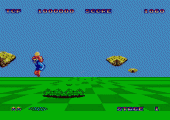
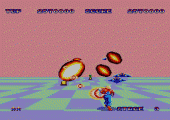
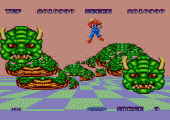
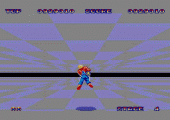
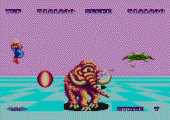
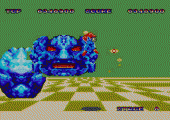
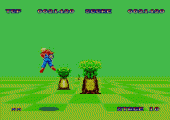
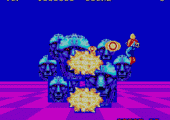
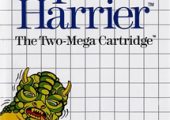
I played the absolute crap out of this game. I’d give it higher than a 6. The sprites were blocky that’s for sure, but it was a good challenge and the sound track was awesome. The end was pretty good too.